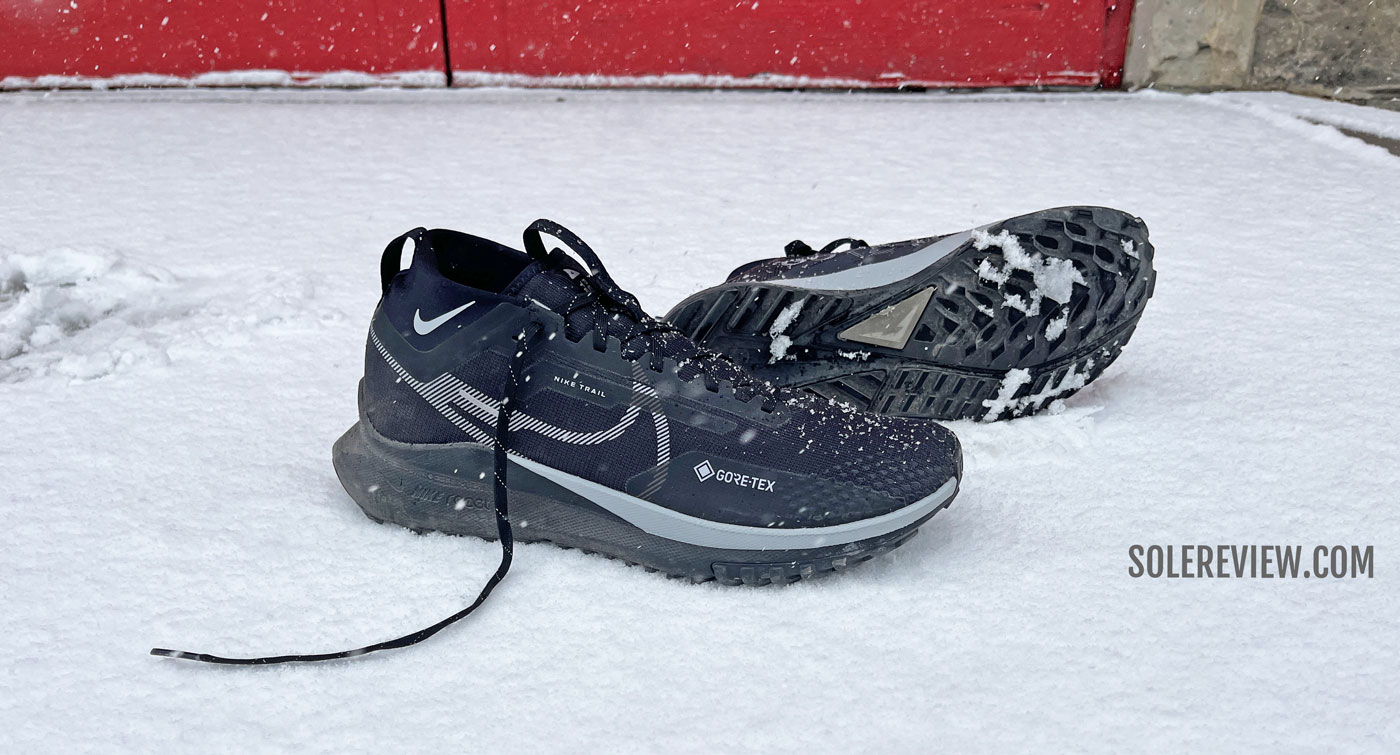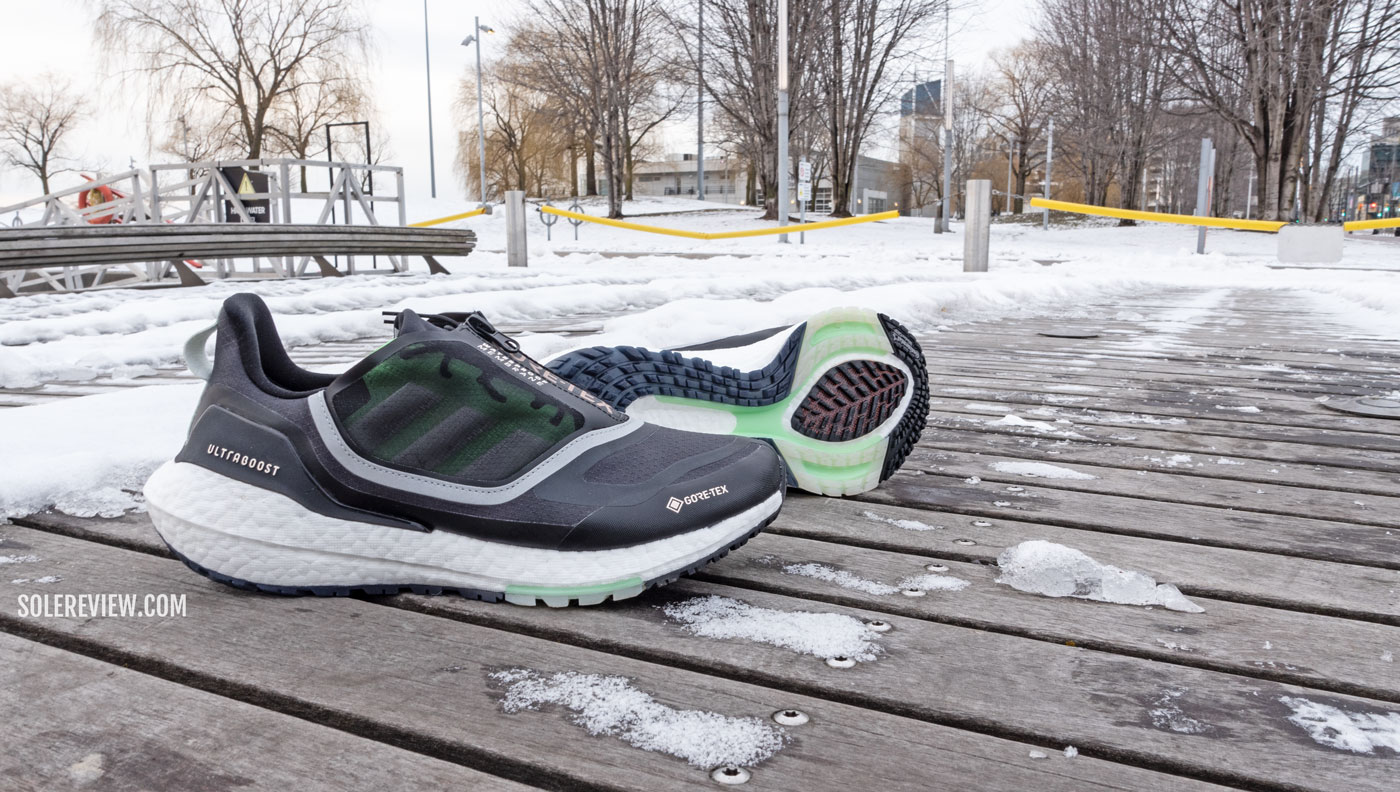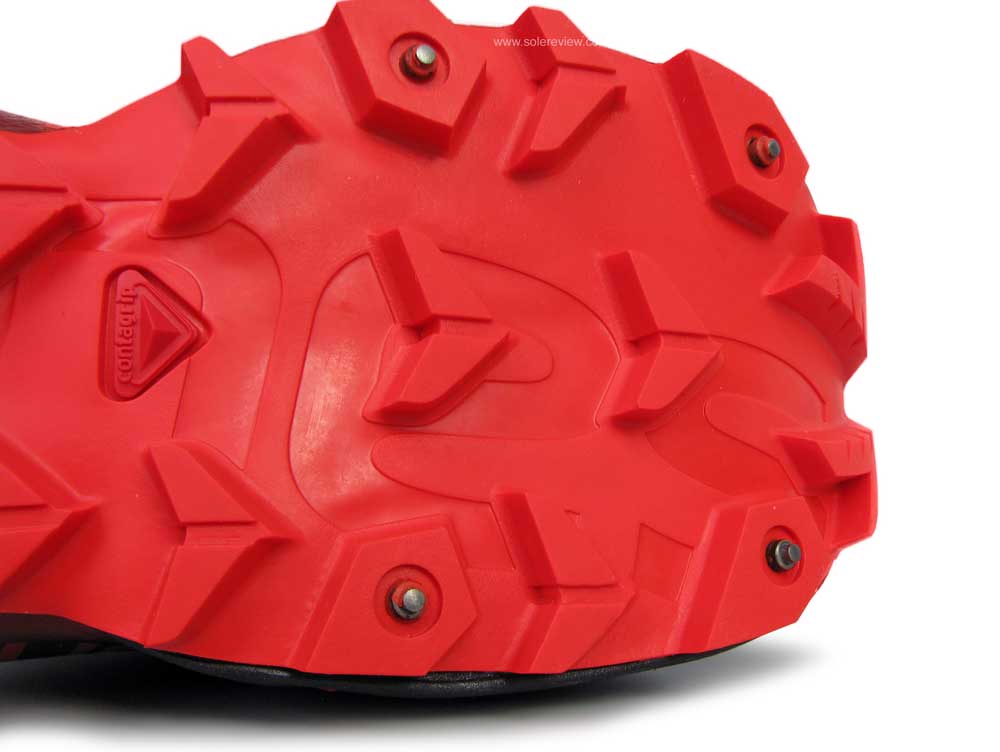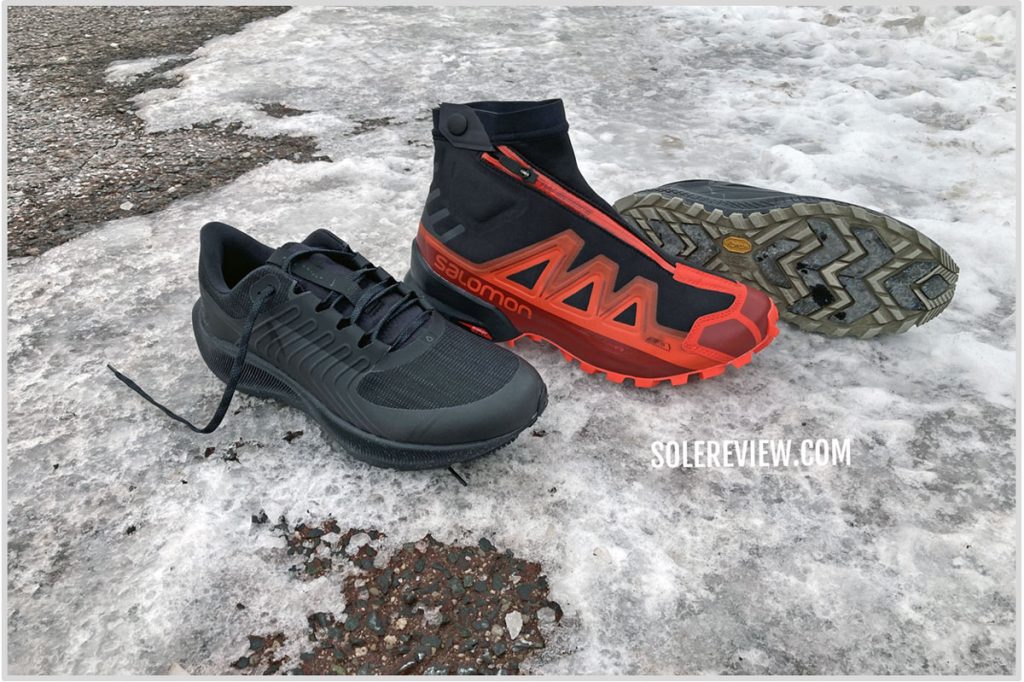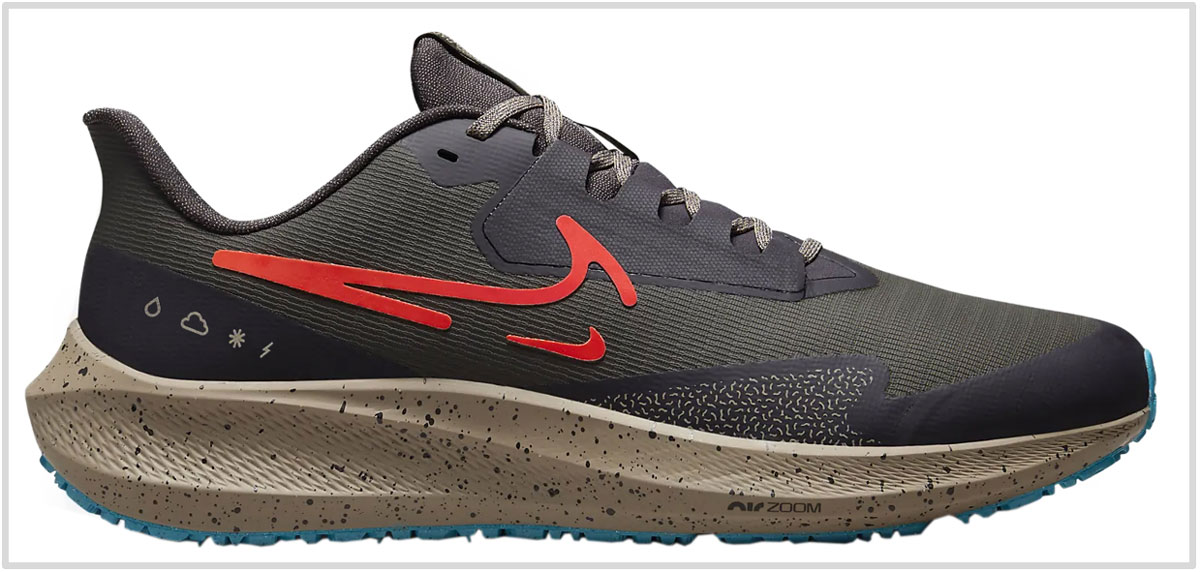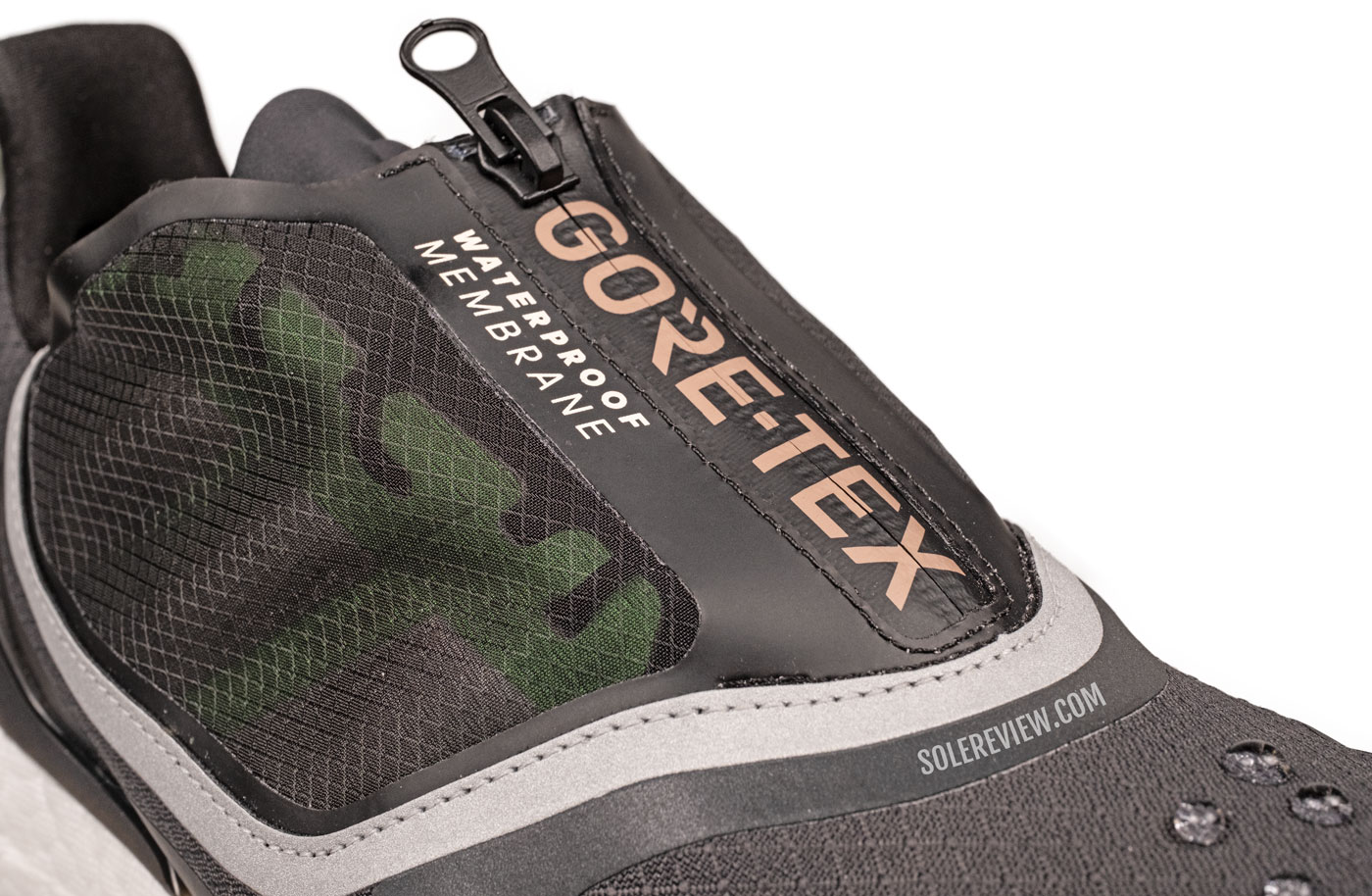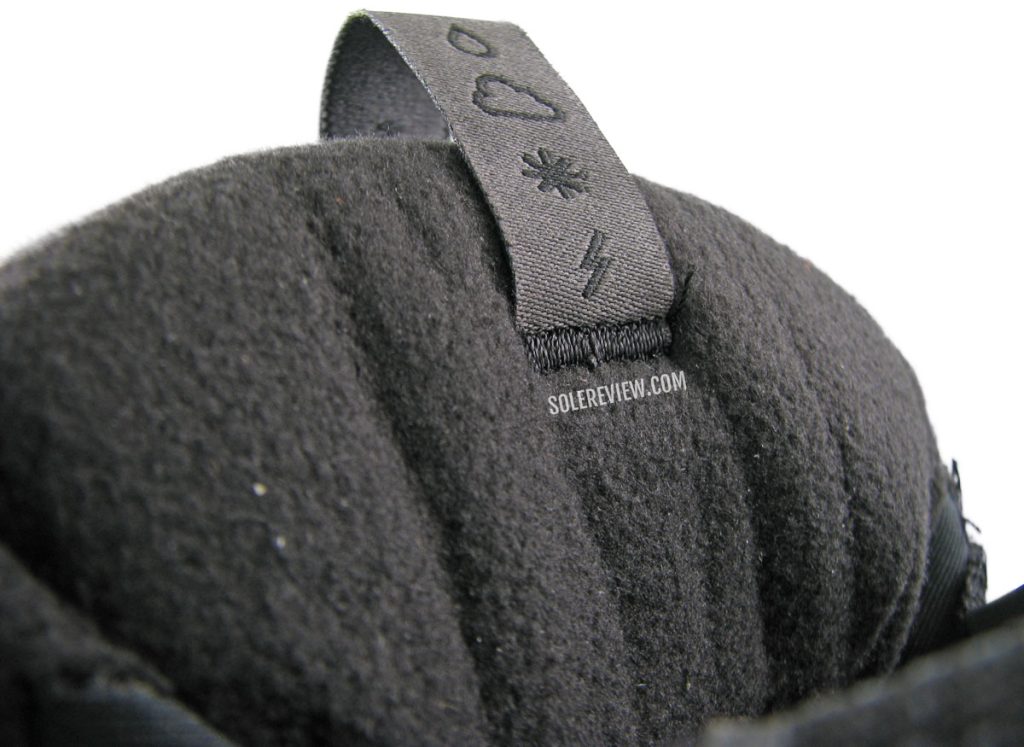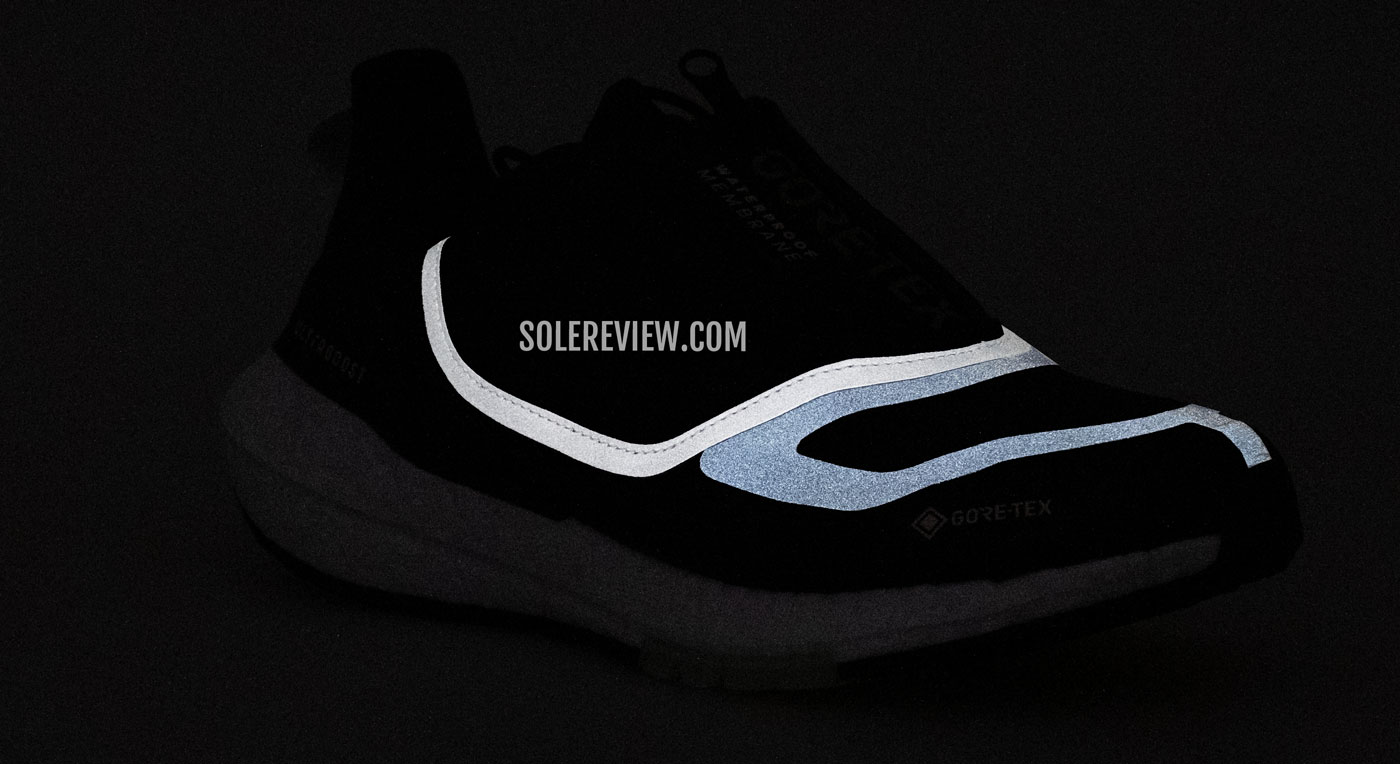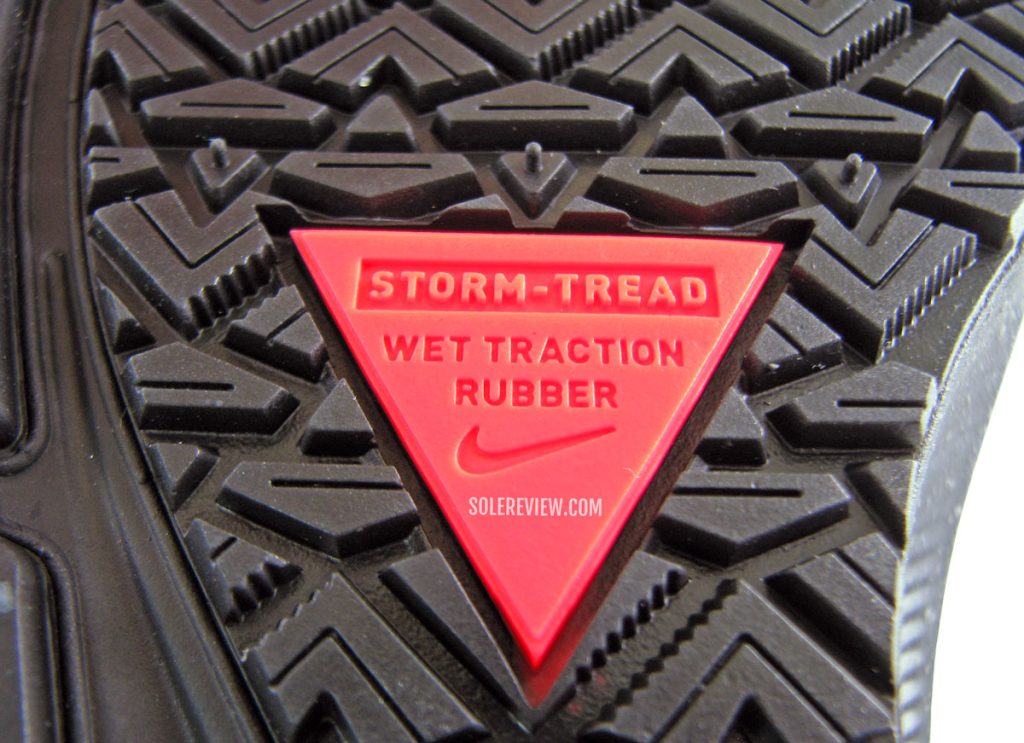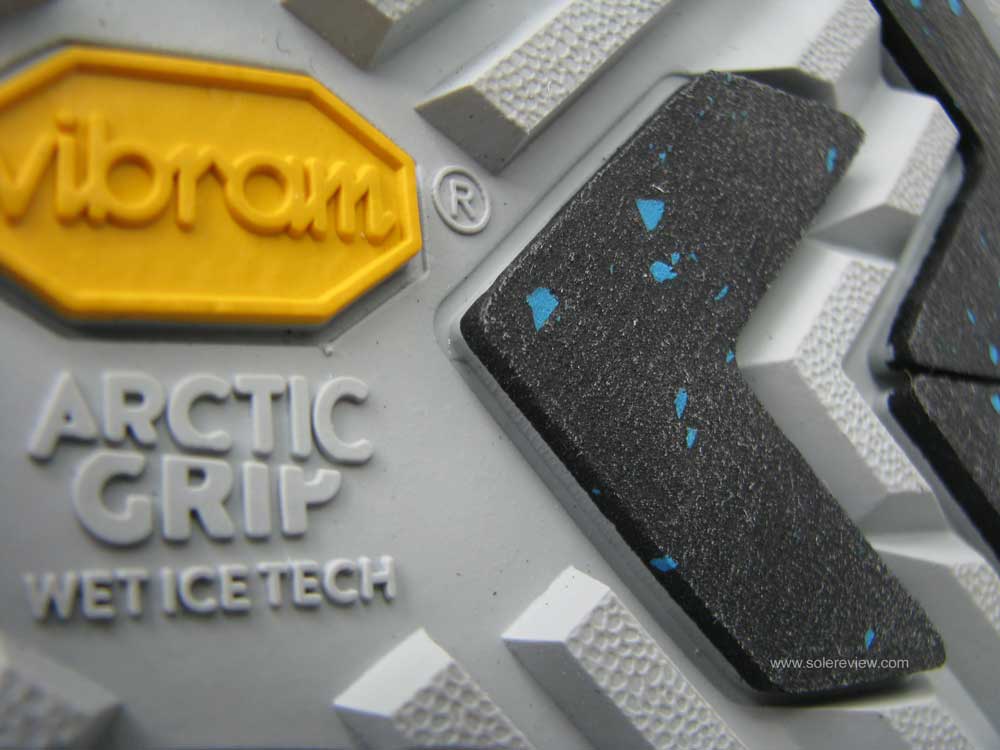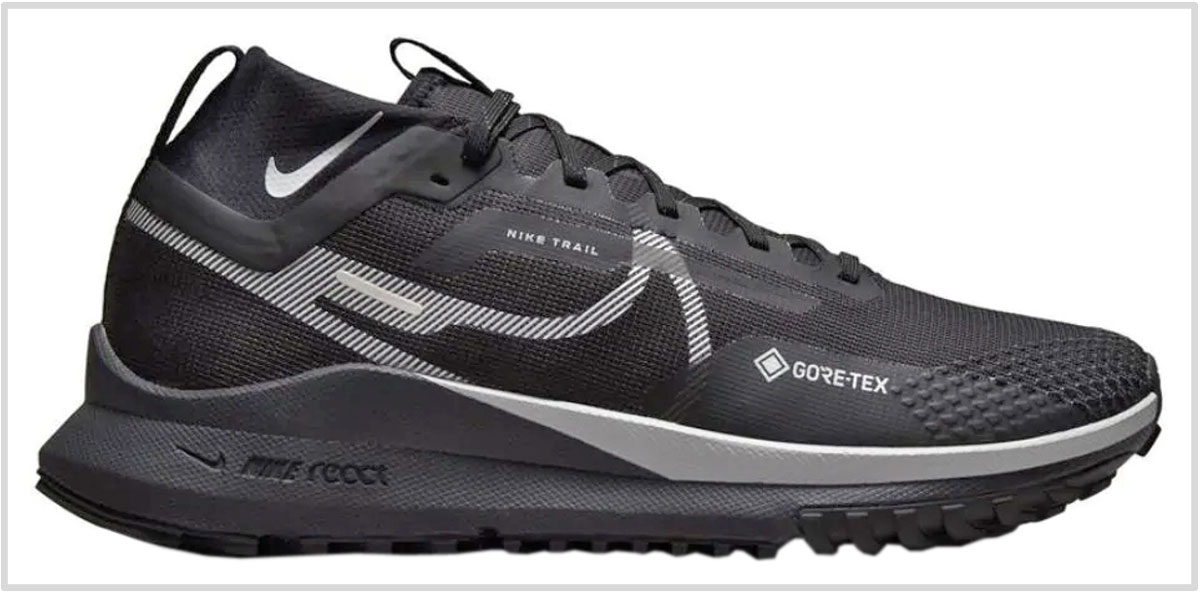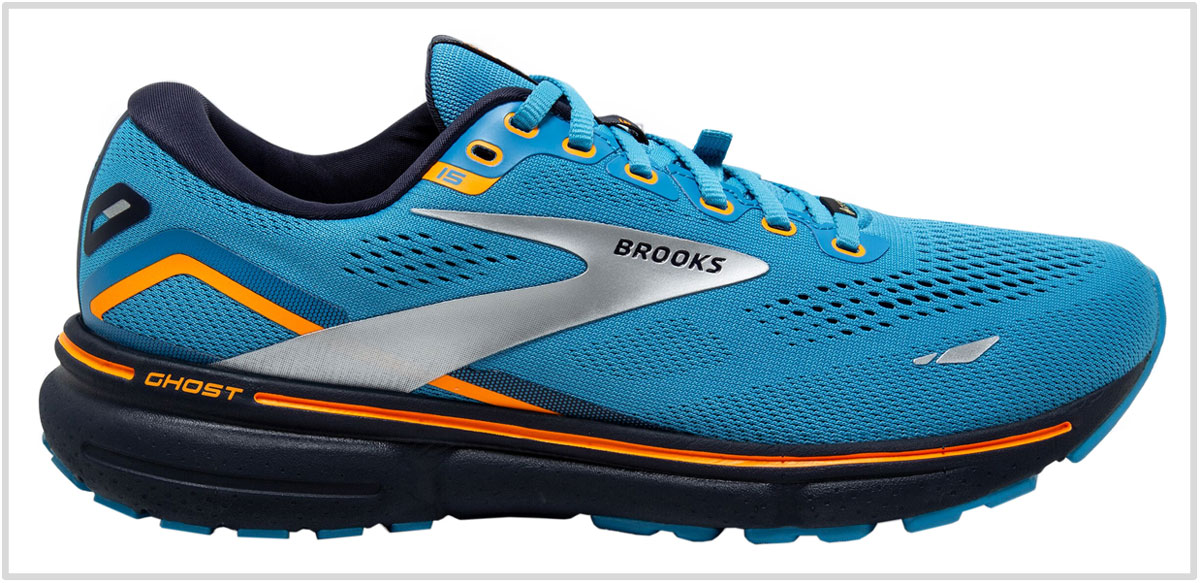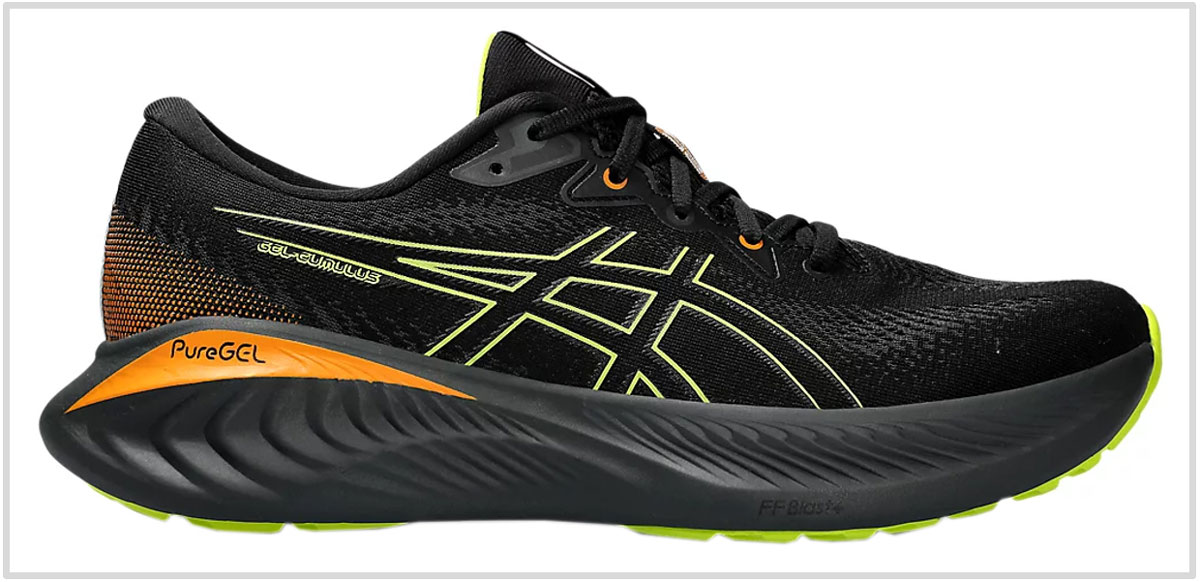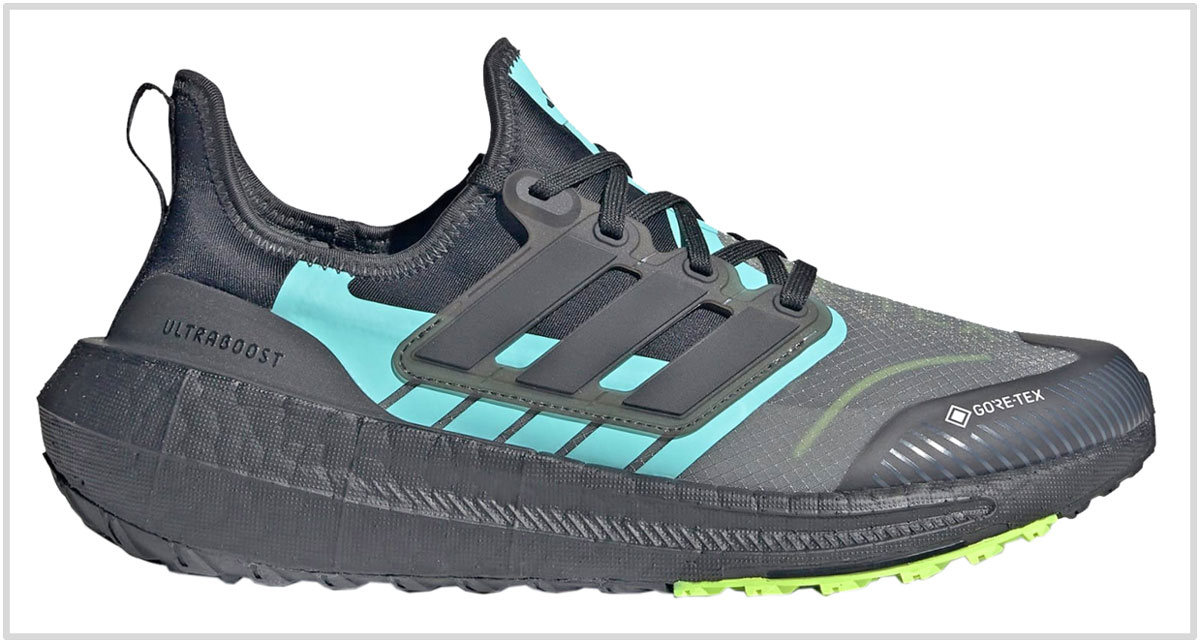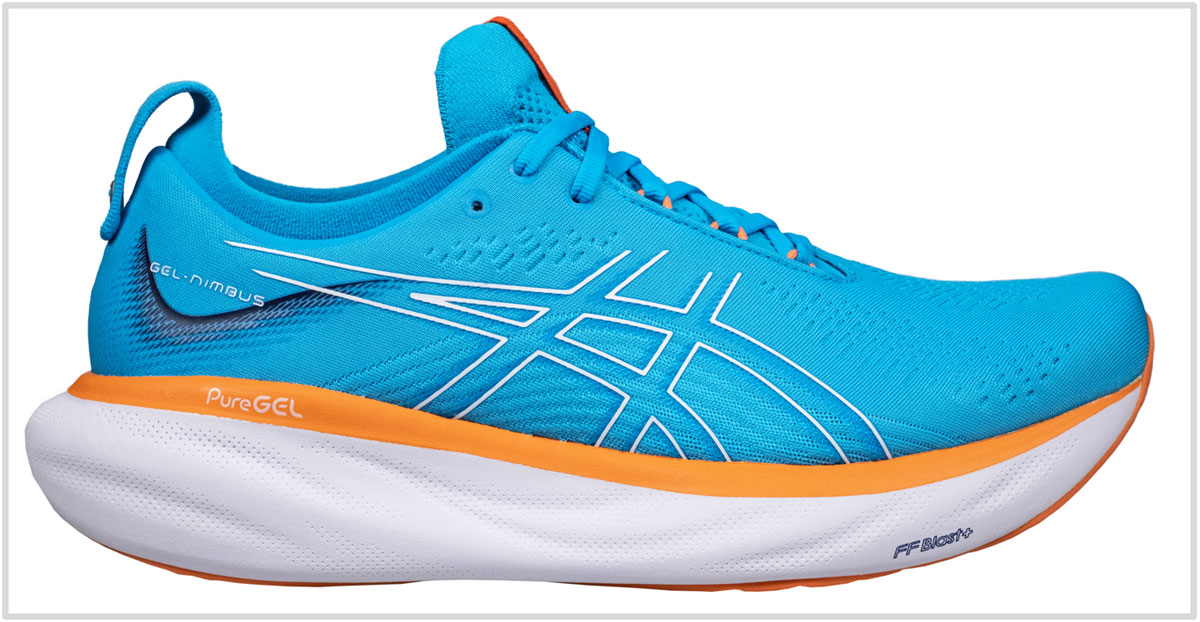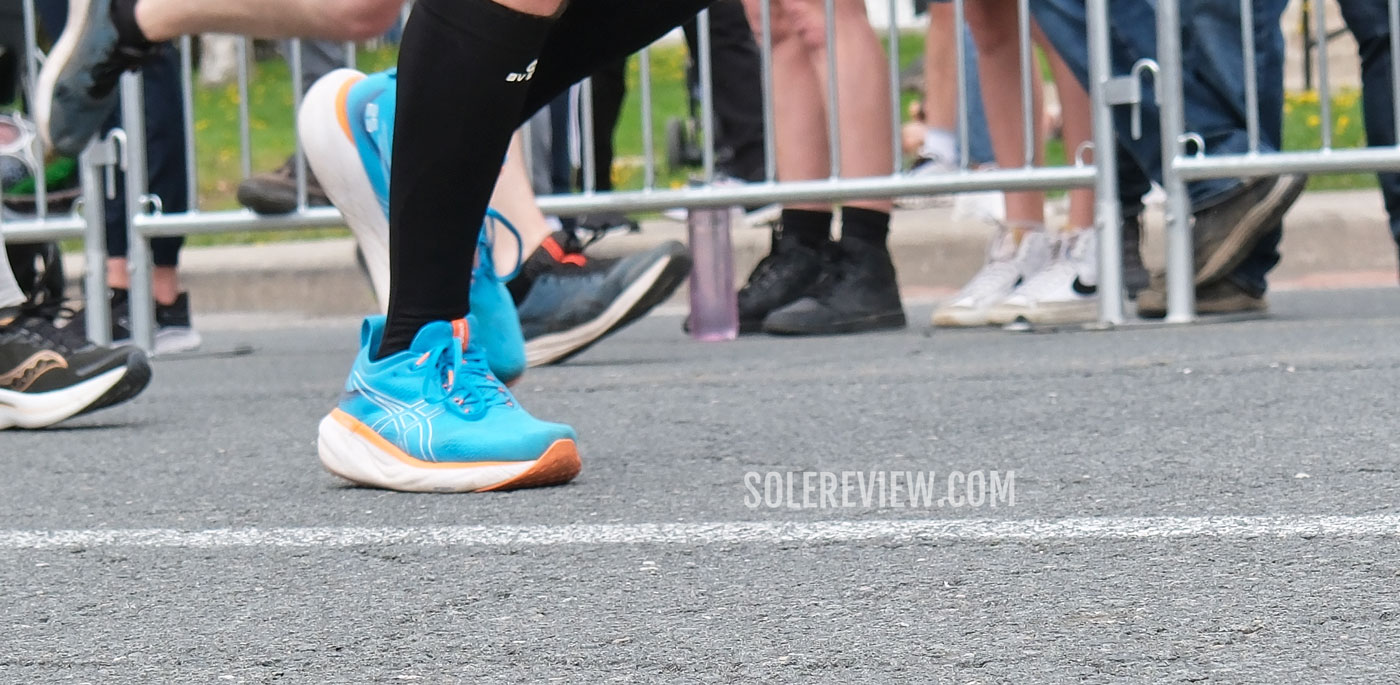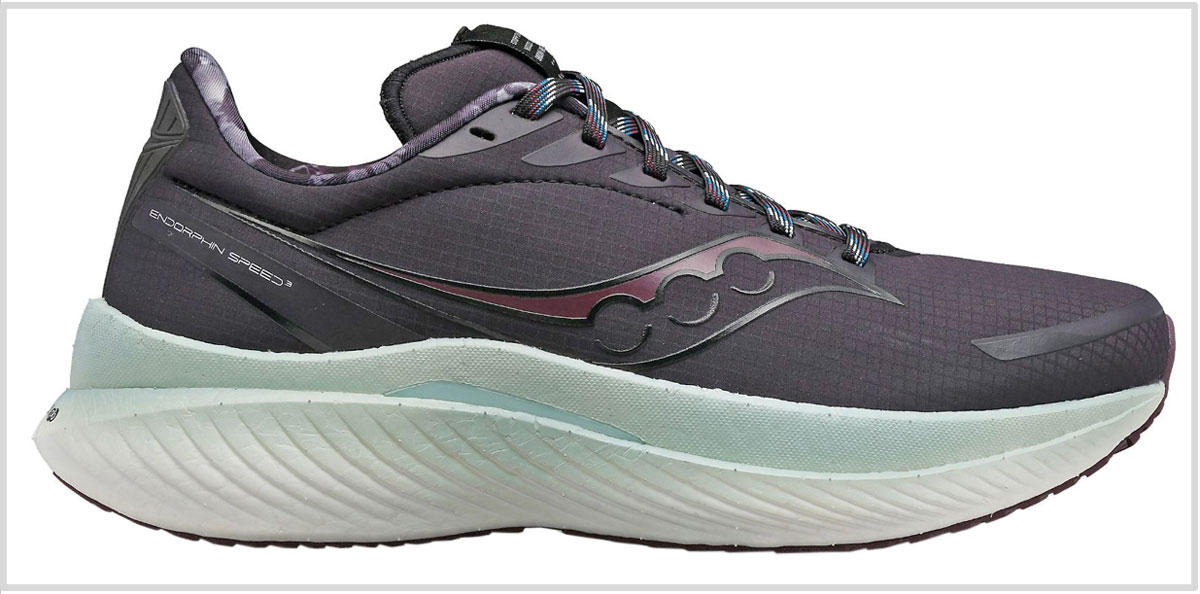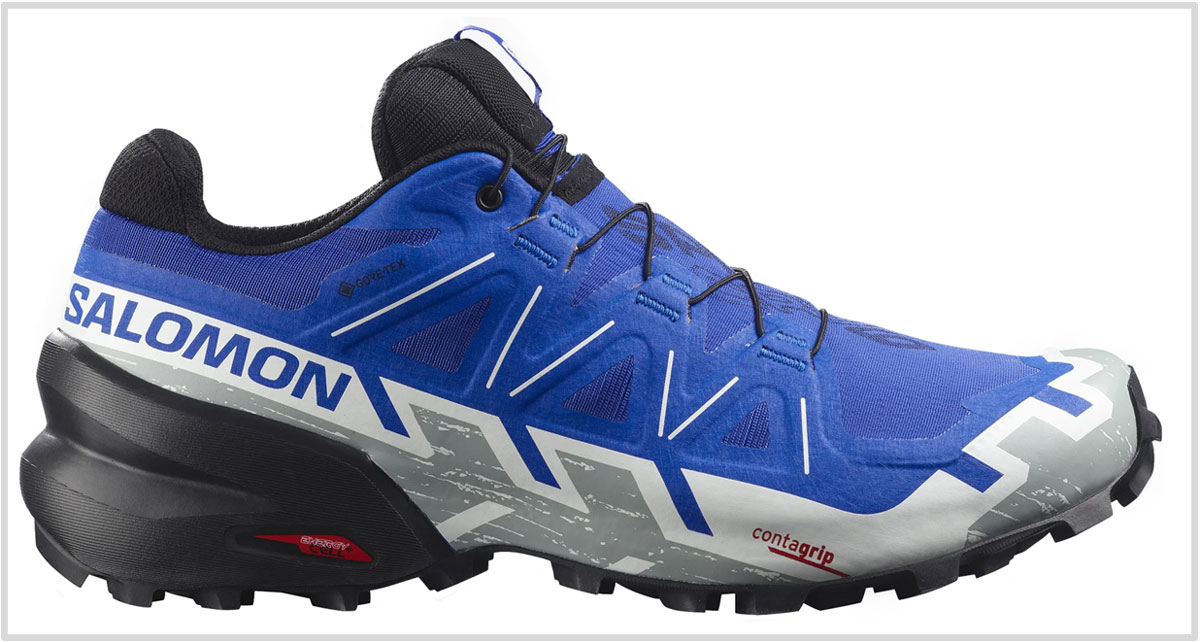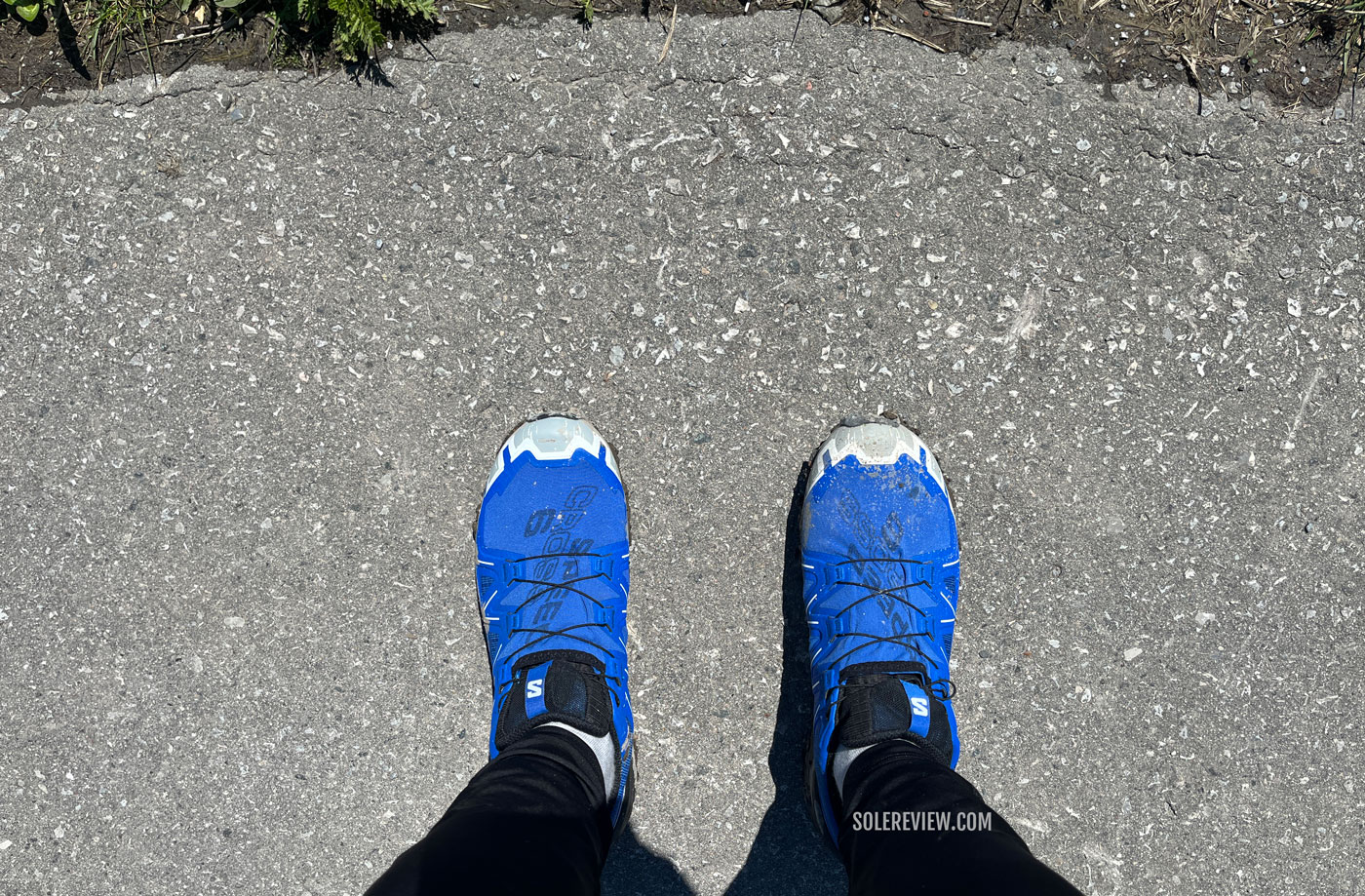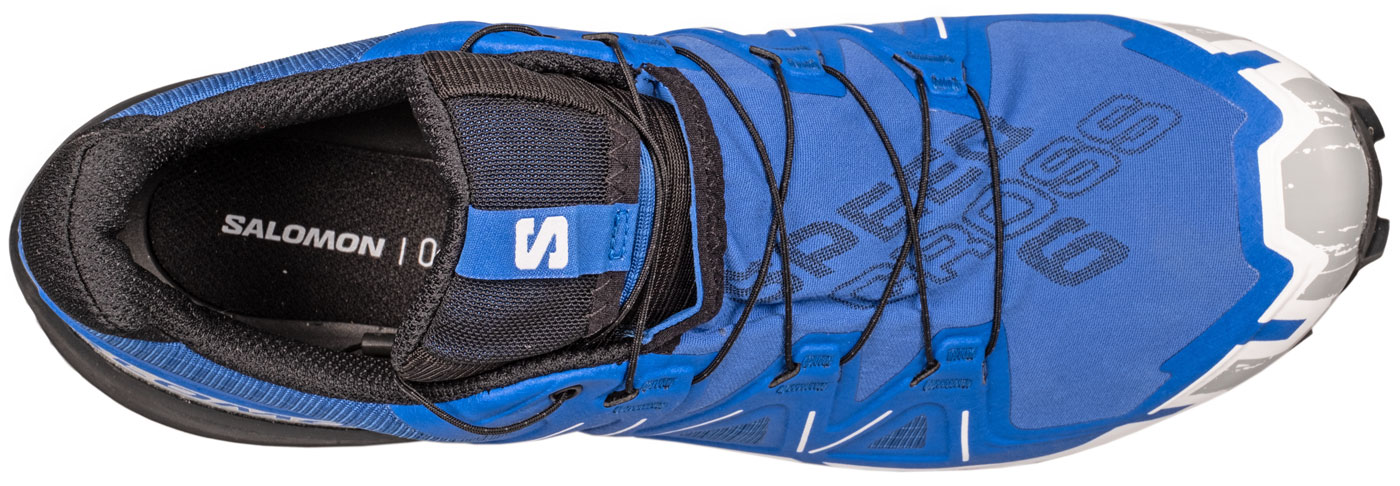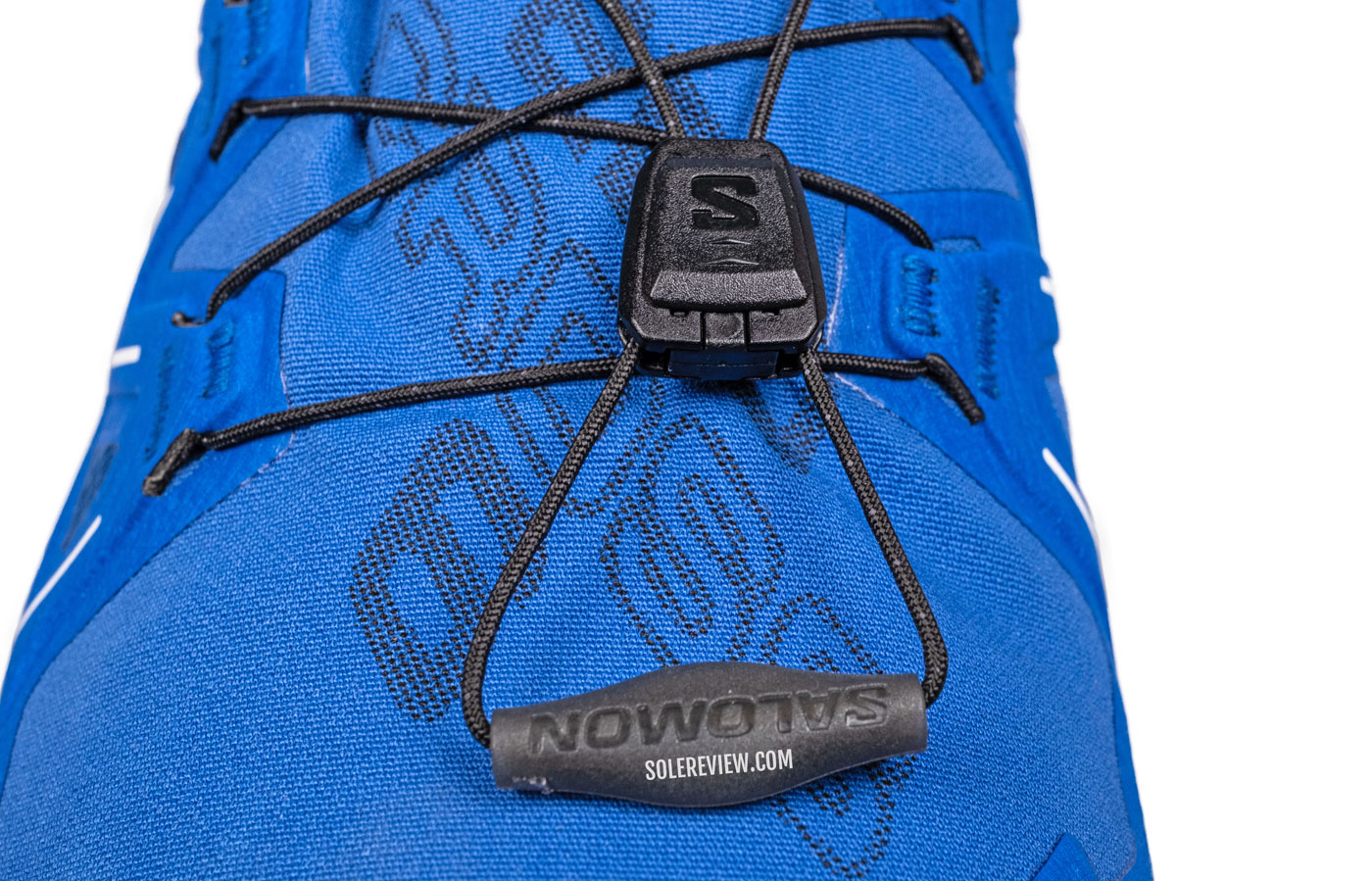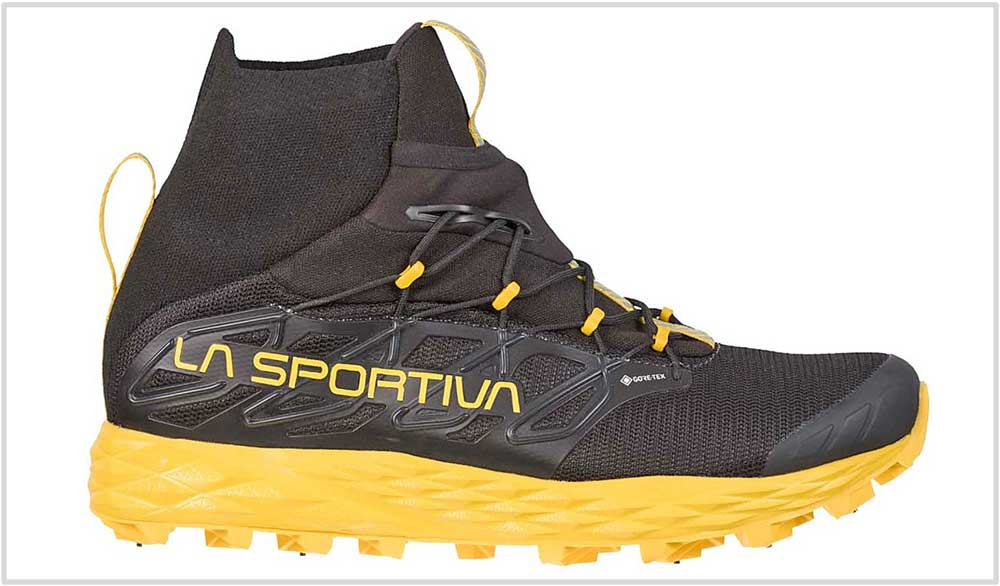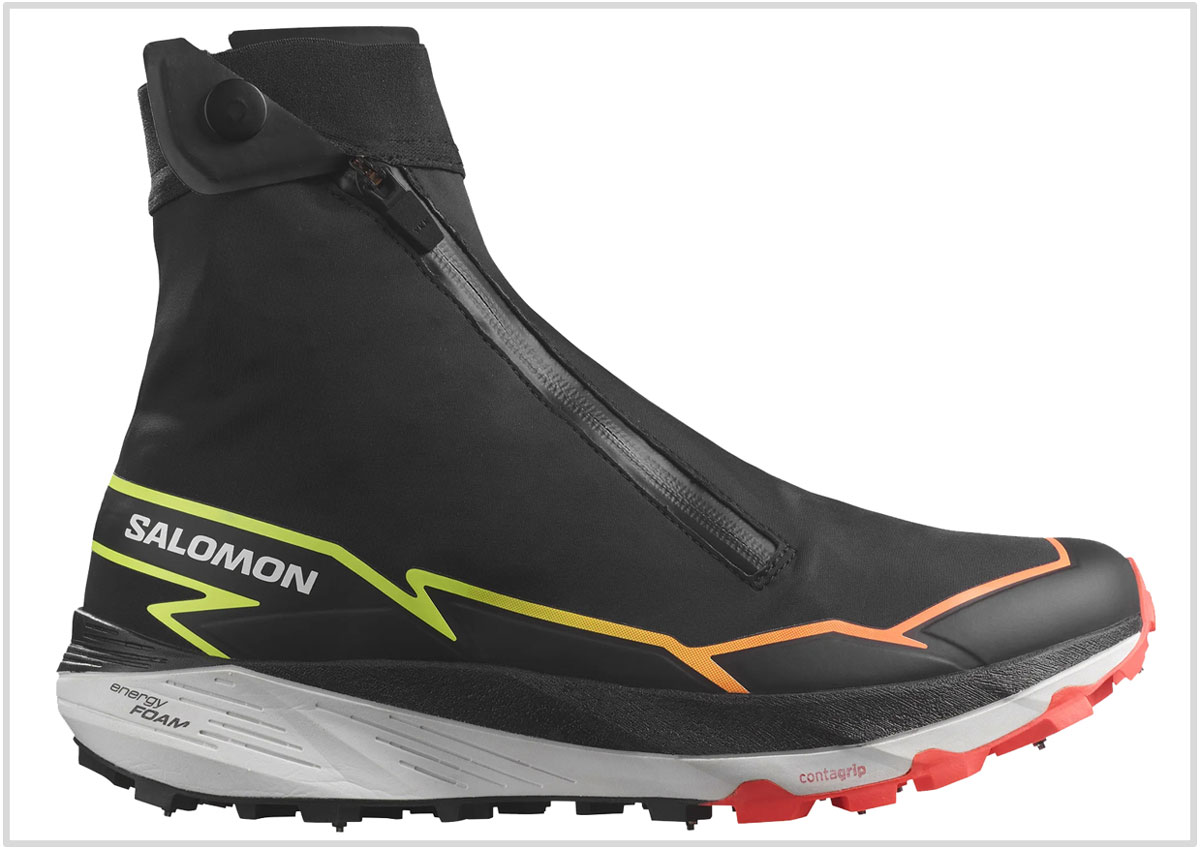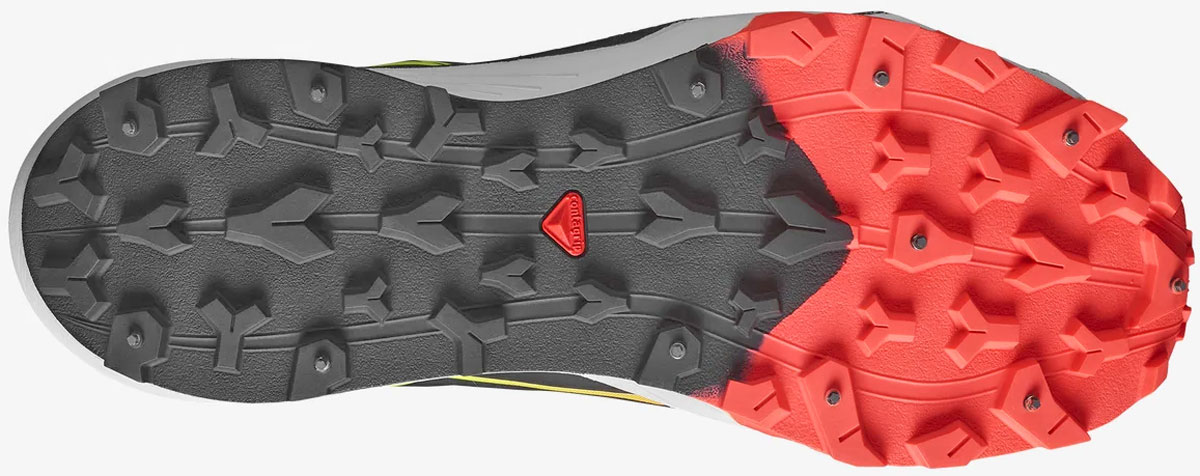This article has been updated with current models for November 2023. Most of the shoes in this guide have been updated with their current versions.
In this product guide:
- 1. Factors to consider
- 2. Road trail hybrid for mild winters: Nike Pegasus Trail 4 GTX
- 3. Daily trainer for mild winters: Brooks Ghost 15 GTX
- 4. Daily trainer for mild winters: Asics Cumulus 25 GTX
- 5. Lifestyle trainer for mild winters: Adidas Ultraboost Light GTX
- 6. Daily trainer for cold winters: Nike Pegasus 39 Shield
- 7. Cushioned trainer with thick upper: Asics Nimbus 25
- 8. Marathon shoe for cold winters: Saucony Endorphin Speed 3 Runshield
- 9. Trail runner for slush and snow: Salomon Speedcross 6 GTX
- 10. Ankle-high trail runner for ice: La Sportiva Blizzard GTX
- 11. Trail runner for icy surfaces: Salomon Spikecross 6 GTX
- 12. Ankle-high trail runner for ice: Salomon Winter Cross Spike
Not all winters are the same. There are places where the ‘winter’ temperatures hover at a comfortable 18° C/65° F.
If that’s the case, you don’t even need to read this article. Just refer to any of our neutral or stability buyer’s guides to pick a shoe. And if waterproofing is all that you need, this article will help.
This curated list has shoe recommendations for both mild and freezing winters.
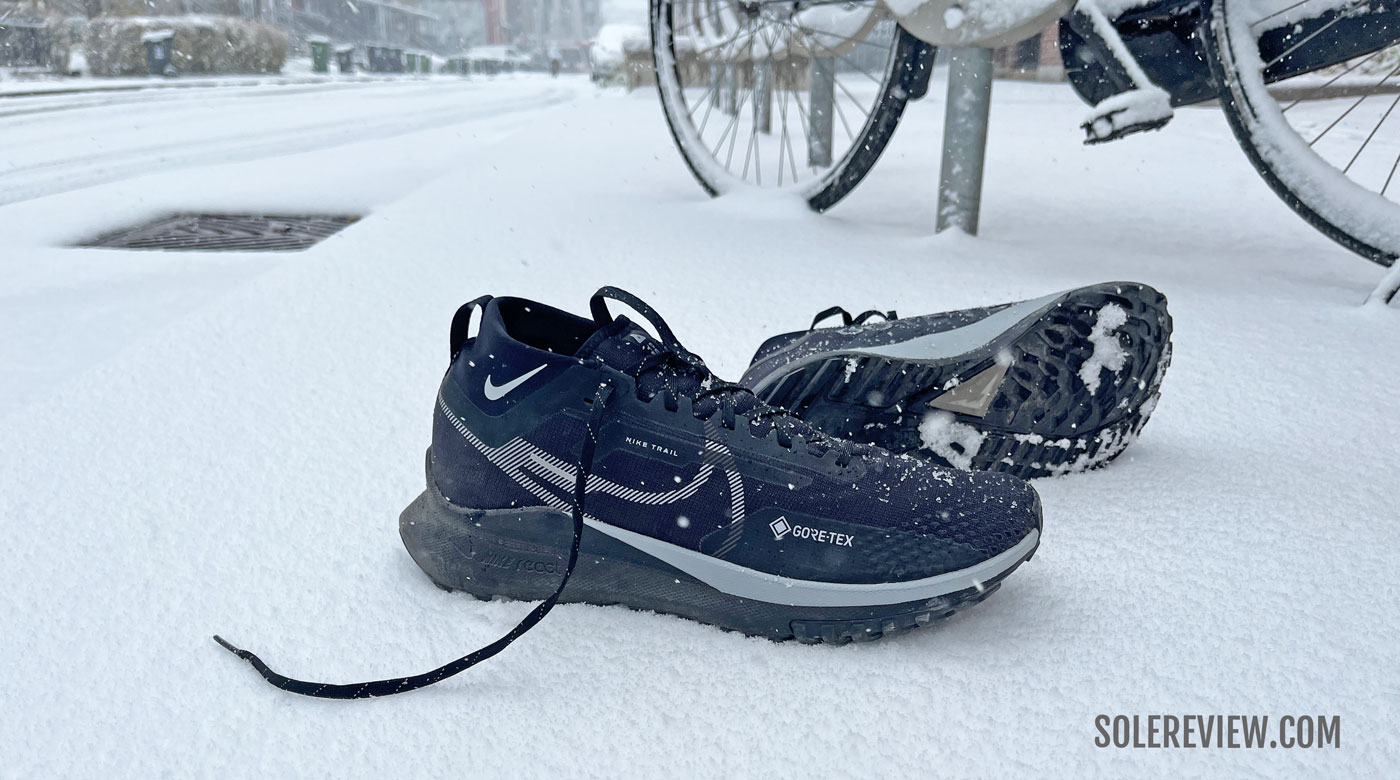
For light snow, even the Pegasus Trail 4 Gore-Tex works just fine. You’ll just need a pair of warm socks, that’s all.
A mild winter never goes below freezing, so a running shoe that repels rain and blocks wind is all that one needs. On the other hand, freezing winters have temperatures of 0° C/32° F and colder. With severe winters also come snow and sidewalks with dangerous surface ice.
That brings us to another topic. Are you going to be running in an urban environment or outdoors? If winter running for you means doing so on snowy trails, then you’re going to need a lot more than mere waterproofing.
Running on ice requires a different set of footwear features – one that includes an outsole designed for ice.
Longer lugs made of soft rubber work well at times, but metal spikes are the only way of getting foolproof traction. On icy roads, even an otherwise ‘sticky’ rubber compound will fail to provide the necessary grip.
Given the context, it makes sense to recommend shoes based on the severity of winter.
We’ll kick off with shoes for mild winters. These all-purpose road running shoes are waterproof (or at least water-resistant) for protection from the winter rains. When worn with the right pair of socks, the upper provides sufficient insulation as well.
Our top pick: Nike Air Zoom Pegasus 39 Shield
The next group has snow-worthy running shoes. A typical scenario would involve running on snowy and slushy sidewalks or flat park trails. Waterproof trail running shoes perform well under these conditions. An aggressively lugged outsole with special rubber will provide decent traction as long as it’s not icy. Here, gaiter attachment points are a bonus.
A different kind of snow running happens outdoors on flat, open trails or in the mountains. Unfortunately, these running paths usually fall outside the jurisdiction of snow-clearing machines. You’re pretty much on your own, so you need an ankle-high running shoe that grips well while keeping the feet dry and toasty.
The last kind of winter running is hardcore, as it involves running on ice-covered surfaces.
Unlike snow or wet roads, slippery ice-covered surfaces are the last place anybody would want to run on. But you know what? Some runners do run on ice, so the fourth category covers ice-friendly running shoes.
Based on our experience, here are the features a winter-running shoe should have. The weightage of each attribute will depend on the severity of winter, but most shoes on this guide have them in some form or the other.
A) Waterproofing: Regardless of whether you’re running in snow-free winters or a snowstorm, a water-repellant upper is a must-have. The use of a Gore-Tex membrane is a good marker of waterproofness but proprietary technologies from Salomon are equally effective.
Winterized running shoes from Asics AWL, New Balance Permafrost, Nike Shield, and Saucony Runshield assortment also offer a reasonable degree of water resistance and warmth.
B) Thermal insulation: Most waterproof shoes meet this criterion when combined with a pair of winter socks.
Running shoes meant for extreme winter will also be made of a durable exterior that blocks the wind.
C) Low light visibility: One doesn’t get a lot of sun during snowy winters, so being seen in low-light conditions is extremely important. Here, a reflective upper is very helpful. For more options, read our buyer’s guide dedicated to reflective running shoes.
D) Choice of a low or high top silhouette: An ankle-high shoe is necessary for off-road winter runs. When worn with a waterproof bottom or gaiter, the extra height will keep the snow, debris, and water out.
E) Outsole traction: Dry, wet, snowy, and icy conditions each demand a different kind of rubber compound and lug geometry. Foolproof ice-running shoes even come equipped with Tungsten Carbide spikes. It is similar to the difference between all-season and winter car tires. This is particularly true of running on the ice where even ‘sticky’ rubbers won’t cut it.
Vibram launched its Arctic Ice outsole with a lot of hype, but Solereview’s experience with this outsole was underwhelming.
The Arctic Grip outsole grips phenomenally on wet surfaces, but it does not inspire confidence over icy surfaces.
While it is certainly better than regular outsoles, our experience demonstrated that it lacks the ice-gripping tenacity that Vibram so enthusiastically advertises.
Then there are other universal requirements. Like a cushioned and supportive ride under a comfortable and secure fit.
Until a couple of years ago, only Nike was consistent with a winter-friendly running shoe assortment. For example, here’s one of our reviews from exactly 10 years ago. In 2011, the Nike Lunarglide 3 Shield was the only purpose-built cold weather adaptation with water resistance and blinding levels of reflectivity.
Today, there’s so much to choose from. Saucony has their Runshield running shoes. Asics sells AWL (All Winter Long) versions of their popular models that complement the Gore-Tex variants.
For running in cold winters with little to no snow:
These shoes are meant for mild winter conditions without snow. But you might encounter the occasional winter rain and misty conditions that will soak summer running shoes. Here, water-repellent and slush-resistant uppers keep the feet dry.
1) Nike Pegasus Trail 4 GTX
There’s a good reason why a road-trail shoe is featured at the top of this guide.
Despite the Pegasus Trail 4’s off-road positioning, this shoe is a versatile winter running shoe that works equally well on the road.
Unlike the Pegasus Trail 3’s single-piece trail outsole, the Pegasus Trail 4 uses a multi-piece layout that’s less aggressive. The shallower forefoot lugs are road-friendly, whereas the ribbed lugs on the side and heel provide traction on slushy surfaces.
The midsole is made of React foam, so there’s ample comfort for the road. Just know that the React foam turns stiff in cold temperatures, so the ride experience is weather-dependent.
The built-in heel gaiter is an effective middle-ground between the traditional low-cut and ankle-high silhouette, as it does a good job of keeping the debris and cold out.
This is the Gore-Tex version of the standard Pegasus Trail 4, so the waterproof upper keeps the moisture out during rainy runs. The upper is not insulated, but waterproof uppers are effective windbreakers. Our in-depth review is here.
2) Brooks Ghost 15 GTX
The Ghost 15 GTX is a road shoe throughout, and it doesn’t pretend to be anything else. From the outside, it’s hard to tell that this is a waterproof shoe. On the road, it’s identical to the standard model – a review of which can be found here.
The upper runs a little warmer due to the said waterproof lining, so it’s a reliable daily trainer pick for mild winters. Given its design limitations, the Ghost 15 GTX is not recommended for ultra-cold runs.
The GTX variant gets the identical single-density midsole as the road-going Brooks Ghost, so there’s lots of ride comfort for most runs – be it daily workouts or high-mileage runs.
Reflectivity is also present in trace amounts. Small trims over the forefoot and heel help build the Ghost 15’s case as a winter running shoe.
Also see: Hoka Clifton 9 GTX.
3) Asics Cumulus 25 GTX
The Asics Cumulus 25 GTX isn’t a winter running shoe per se. It’s very much like the Ghost 15 GTX – a waterproof running shoe for cold winter runs that do not involve snow or ice.
Nonetheless, the Gore-Tex variant of the Asics Cumulus 25 is a sensible winter running shoe pick. When paired with woolen socks, this shoe is good enough for most non-snowy winters.
A Gore-Tex lining blocks the water from entering, and it’s just as effective as keeping the wind out. Even though the upper isn’t insulated or quilted, blocking the wind drastically cuts down the cold.
The Flytefoam midsole is very comfortable, with just the right balance of cushioning softness and smoothness. The true-to-size fit has a please-all quality and uses plush materials for a comfortable interior.
Reflectivity is only found on the heel. For a higher level of low light visibility, consider the Cumulus 25 Lite-show instead.
4) Adidas Ultraboost Light GTX
We’re glad that adidas ditched the convoluted zipper shroud of the Ultraboost 22 GTX for a simpler set-up that works just as well.
For this year, the Gore-Tex version of the Ultraboost Light (aka Ultraboost 23) has a bootie entry with traditional lacing. The Gore-Tex membrane makes the upper waterproof, whereas the fused mudguards and ripstop mesh act as effective wind blockers.
Some of the design elements on the adidas Ultraboost Light Gore-Tex are recognizable from the standard model; there’s a full-length midsole made of Boost foam under the plastic heel clip.
In essence, the winterized Ultraboost delivers the same cushioning comfort as the regular model. However, this version is more than just a waterproof variant. For example, the Continental rubber outsole is specifically designed for cold weather. The outsole combines small aggressive lugs with a sticky compound called Winter grip. Like most shoes, this outsole is ineffective on ice, but performs well on wet and slushy roads.
The adidas Boost foam doesn’t stiffen in the cold, so that’s a bonus.
5) Nike Pegasus 39 Shield
Except for the cushioned React foam and Zoom Air midsole, there’s not much that the Pegasus 39 Shield has in common with the road Pegasus 39. Or for that matter, the standard Pegasus 40.
Many novel features are exclusive to the winterized Pegasus. The outsole has an aggressive geometry, and it’s made of a sticky rubber (Storm tread) for superior performance over damp surfaces.
The new outsole is an improvement over the Pegasus 38 Shield, since the entire outsole gets the sticky rubber treatment. On the Pegasus 38 Shield, the side crash rails were made of smooth rubber lugs.
The upper does a decent job of keeping water out. The Pegasus 39 Shield is not waterproof, but merely water repellent. Making that happen are the coated midfoot panel, bumper, and a closed forefoot mesh. The protective design is also good at blocking the wind and cold; think of the shoe as a rain jacket.
The low level of reflectivity was puzzling on the previous model. Thankfully, the Pegasus 39 Shield addresses the visibility concerns. The large Nike Swoosh logo on the upper is reflective, and so are the smaller trims on the side.
For a less expensive alternative, consider the Nike Winflo 9 Shield.
6) Asics Nimbus 25
The Asics Nimbus 25 is neither waterproof nor reflective. So why is this shoe here?
If you live in a place with dry and mild winters, the Nimbus 25’s thick upper will do the trick during the slightly colder months. A pair of thin wool socks will yield better results.
Unless you were living under a rock, you’d know that the Nimbus 25 has been completely redesigned. New for this year is a deeper and livelier cushioning that takes the Nimbus in a different direction than before. The Flytefoam midsole is comfortable enough for a marathon, and it no longer feels slow – as was the case a few years ago.
The outsole grip isn’t great on wet roads, so watch out when running under damp surface conditions.
7) Saucony Endorphin Speed 3 Runshield
The Endorphin Speed 3 is also offered in a Runshield flavor, thus making it the only winterized shoe with a PEBA foam midsole and an internal plate.
The cold weather modifications made to the Endorphin Speed create a warm interior. Instead of the breezy mesh seen on the standard Speed 3, the Runshield version uses a ripstop textile and dark colors.
The tightly woven mesh and light insulation offer a fair degree of wind and moisture resistance.
Under the water-repellent upper is the same midsole and outsole used on the (standard) Endorphin Speed V3. In other words, the Runshield Speed 3 has a soft and responsive ride that makes long runs comfortable, yet fast.
Outdoor snow running shoes:
This is where things get serious. Outdoor running – be it on mountainous or forested terrain – means deeper snow, freezing slush, and more debris. Under such conditions, a high-top shoe prevents the outside from getting inside.
8) Salomon Speedcross 6 Gore-Tex
The Salomon Speedcross 6 isn’t a winter shoe per se, but it has many features that make it a decent cold-weather shoe.
Not only does the Gore-Tex membrane prevent water from entering, but it’s also effective at blocking the wind.
Also, only the top of the forefoot and tongue has soft mesh; the sides are layered with molded synthetic. These panels act as a barrier against the cold and are easy to wipe clean. For example, salted sidewalks tend to create quite a mess, and the smooth mudguard is easy to maintain. Our review is a good place to learn more about this product.
The snug upper provides decent insulation when worn with a pair of wool running socks. The bungee cord lacing is also quick to lace with gloved hands.
The Speedcross 6’s firm cushioning is very stable under less-than-ideal surface conditions, and the Contagrip outsole grips well on slush and damp roads.
9) La Sportiva Blizzard GTX (With spikes)
The waterproof La Sportiva Blizzard GTX is a ‘mildly’ spiked shoe. Unlike the Salomon Winter Cross Spike or the IceBug NewRun, (with their 12 and 17 spikes respectively) the Blizzard is equipped with just 9 spikes.
While the Tungsten Carbide spikes provide grip over icy surfaces, the long (7 mm) and aggressive rubber lugs are equally important on the trail. The lugs are spaced wide to prevent clogging.
The upper isn’t very easy to get into. Unlike the more commonly seen gaiter design that includes a zipped external bootie (like adidas and Salomon), the Blizzard relies on an elasticated collar for entry. So if you’re used to the zipper design, working your foot inside the La Sportiva is a bit of a chore.
On the bright side, the upper is insulated very well against the elements. This is a Gore-Tex-lined shoe so the Blizzard is waterproof.
The cord lacing loops through enclosed midfoot hooks for an excellent lock-down. Once the laces are cinched, those can be tucked into a small pocket over the instep.
If you go by just the ease of use, we prefer the waterproof Salomon Snowspike. But the Blizzard GTX gives you the option of retrofitting additional spikes – something that the Salomon shoe lacks.
Ice Running shoes:
Are you willing to trade the comfort of your treadmill for running in the icy outdoors? These shoes will serve you well.
10) Salomon Spikecross 6 GTX
This extreme adaptation of the Salomon Speedcross 6 adds a dozen spikes to an already sticky Contagrip outsole.
The spiked outsole delivers universal traction on loose/compact snow and ice. Mind you, both the SpikeCross and the Snowcross are not meant for use on the roads, cleared sidewalks, or indoor floors.
Just like the Speedcross 6 GTX, the upper is protected from the outside by a full Gore-Tex bootie. Cinching the shoe is easy with the bungee quick-lace system – which is just the thing for gloved hands during the cold winters. The sizing fits snugly, but is true to size.
11) Salomon Winter Cross Spike
The Winter Cross Spike is an update to the Snowspike CSWP, a shoe that we reviewed on this site a few years ago.
So what has changed? The Winter Cross Spike uses a regular running shoe midsole (with a 4 mm drop) instead of the double-lasted (same as Speedcross) midsole that the CSWP had. This makes the Winter Cross lighter as well as a softer shoe to run in. There is some trade-off in the stability department, so the Winter Cross is better suited for urban environments and non-technical trails.
A full shoe upper with a bungee quick lacing system is covered by an ankle-high water-resistant shroud. The zipped bootie is also a wind blocker so the feet stay warm when it’s freezing outdoors.
Just like the SpikeCross GTX, the Winter Cross spike’s outsole combines a traction-friendly rubber compound with a dozen Tungsten Carbide spikes.
All-weather traction is what makes a running shoe truly winter-worthy, and this is where both the Salomon shoes deliver. The 5 mm deep lugs offer a dependable grip in soft snow while the spikes make running on compact ice worry-free.
The molded footbed over the midsole adds comfort – both at a step-in level and over longer distances.
While the shoe is easy to wear and take off, the fit is snug when worn with a pair of thick woolen socks. Buying a half-size larger will solve that problem.
Do you own this shoe? Improve this review by sharing your insights – submit a review here.

